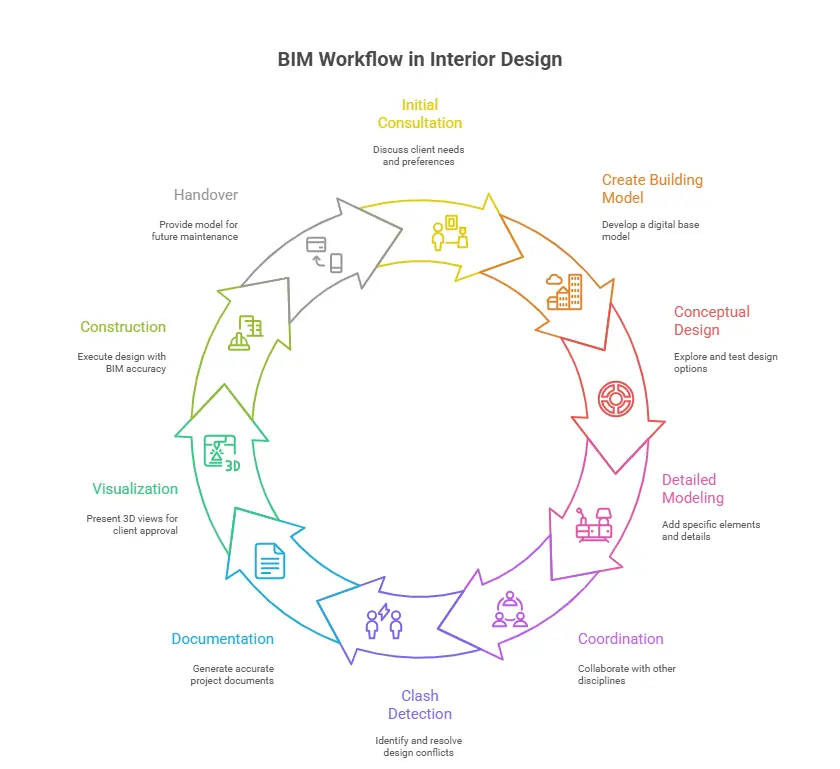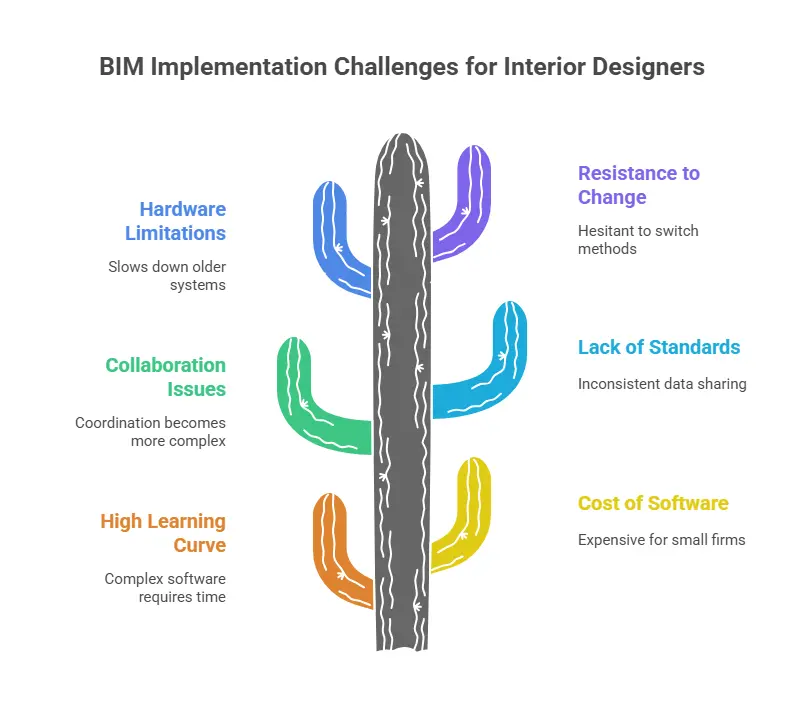Table of Contents
Interior design is rapidly evolving, and technology plays an important role in that change. One of the most powerful tools transforming the field today is Building Information Modeling (BIM). Initially developed for architects and engineers, BIM now helps interior designers plan, visualize and manage their projects with greater accuracy and creativity. In this blog, we will explore how BIM makes the design process easier, what advantages it offers, and the exciting career opportunities it opens up for interior designers.
Get Career-Oriented BIM Certification Course with Expert Mentors! Get a free demo here!
Introduction
Building Information Modeling (BIM) is a digital system that helps interior designers create and manage special 3D models of interior areas. Unlike traditional design techniques, which depends on 2D designs, BIM allows designers to create an intelligent, data-rich model that contains records about every element of a room – from walls and furnishings to lighting and materials.
In case of interior designing, BIM allows specialists visualize how distinctive components will look and works together before the actual construction starts. Designers can easily do experiment with layouts, color schemes, textures and the materials, ensuring that every choices suits within the budget and technical requirements of the project. Because the BIM models stores detailed informations on every item, it also makes easier to calculate cost, find materials and make quick updates when customers request changes.
What is BIM?
Building Information Modeling (BIM) is a smart digital process used to design, construct and manage buildings and interior spaces more efficiently. It allows the professionals to create a detailed 3D model that includes not only the visual design of a project, but also important information about materials, costs, structure, lighting and maintenance of each project. Unlike the traditional 2D drawings, BIM provides a complete picture of the physical and functional characteristics of a building in a design view.
A Digital Representation of the Real World
BIM acts as a virtual model of a constructing earlier than it’s really constructed. It combines geometry, facts, and real-global conduct to help designers and architects recognize how a task will appearance and carry out. Every element in a BIM version — from walls and home windows to furniture and electrical structures — incorporates precise facts that can be up to date, shared, and analyzed. This makes it less difficult to make adjustments early inside the layout method and keep away from expensive errors afterward.
How BIM Works
BIM isn’t simply software program; it’s a collaborative system. Multiple specialists — such as architects, engineers, and interior designers — paintings together on a shared digital version. Any trade made via one crew member is straight away reflected for every person else. For example, if an interior designer movements a wall, the architect and engineer can right away see the update and adjust their paintings accordingly. This actual-time collaboration saves time, reduces confusion, and maintains tasks walking smoothly.
BIM is changing the manner buildings and interiors are designed and managed. It brings creativity and era together, supporting professionals deliver higher effects in less time. As industries circulate closer to smarter and extra sustainable creation, mastering BIM has become essential for anyone worried in architecture, engineering, or interior design.
Importance of BIM in Interior Design
Building Information Modeling (BIM) has become an important device within the current indoors design enterprise. It facilitates designers create, visualize, and manipulate areas greater correctly and efficaciously. Unlike conventional 2D drawings, BIM lets in designers to work with distinctive three-D fashions that consist of all of the records wished to plot, construct, and keep an indoors area. This era makes the design technique greater creative, prepared, and collaborative.
🔸Better Visualization and Design Accuracy
One of the most important benefits of BIM in indoors design is its capability to create realistic 3D visualizations. The Designers can display customers precisely how a space will look — like overall furnishings, lights, colours, and textures — before any construction starts. This helps clients make more understandable decisions and reduce the probabilities of misunderstandings. Because each details inside the BIM model is based totally on actual dimensions, designers could include certain things that suits perfectly within the space.
🔸Enhanced Collaboration and Communication
Furnishing tasks often involve collaboration between designers, architects, engineers and contractors. BIM allows all people to work with the same version in real time, making verbal exchanges easier and more transparent. When a team member make changes, it is automatically updated to everyone else. This shared platform helps avoid layout confusions, saves time and keeps the whole team together.
🔸Efficient Project Management
BIM helps interior designers manage projects more efficiently. The system stores important details which include material specs, fees, and schedules, permitting designers to track development and budget greater effectively. If a client requests a design change, the impact on price and substances can be visible at once, supporting with higher decision-making and time management.
🔸Sustainability and Energy Efficiency
BIM supports sustainable design by means of allowing indoors designers to check power performance, lights overall performance, and material choices truely. Designers can examine how herbal light influences a area or select eco-friendly substances that lessen environmental impact. This results in more sustainable and responsible layout outcomes.
🔸Reduced Errors and Rework
Since BIM provides correct, statistics-wealthy models, it facilitates come across design clashes or production problems early. This reduces expensive errors and remodel during the implementation phase.
BIM is transforming interior layout through combining creativity with generation. It enables designers supply greater accurate, efficient, and sustainable results while enhancing conversation and purchaser delight. Mastering BIM is not non-obligatory — it’s a key talent for the future of interior layout.
Key Benefits of Using BIM for Interior Design
Building Information Modeling (BIM) has completely modified the manner interior designers works. It affords a wiser and greater efficient way to plan, visualize, and control design projects. With BIM, interior designers can create detailed 3D models that no longer best show how a space will appearance but additionally encompass treasured information about substances, lights, furnishings, and expenses. Here are a number of the important thing benefits of the use of BIM in interior design.
Realistic Visualization and Better Design Presentation
BIM allows designers to create 3D models of indoor spaces. Clients can see exactly how the finished work will look like, which includes shades, textures, fixtures placement, and lighting fixtures. This makes easier for clients to understand and approve designs, avoid confusion and last-minute modifications. Designers can quickly experiment with different patterns and materials to find a satisfactory combination for the space.
Improved Accuracy and Detailing
With BIM, each element inside the version is created with precise measurements and specs. This manner furniture, fixtures, and finishes are represented as it should be in size and scale. Designers can identify capacity design clashes early — along with a piece of furnishings blocking off a door or mild fixture placement issues — before creation starts offevolved. This accuracy saves time and stops highly-priced mistakes.
Seamless Collaboration and Coordination
Interior design frequently calls for teamwork amongst architects, engineers, and contractors. BIM brings every body together on one shared platform. When a clothier updates some thing in the model, all other team contributors can instantly see the change. This reduces communique gaps, ensures everybody is operating with the cutting-edge layout model, and continues the venture strolling easily.
Cost and Time Efficiency
BIM helps designers control time and budgets more efficiently. The software can robotically calculate material quantities and fees, permitting designers to offer correct undertaking estimates. If changes are made, BIM updates the complete model right away, saving time that would otherwise be spent on redrawing or recalculating.
Sustainable and Smart Design Choices
BIM supports green design by permitting indoors designers to analyze power use, lighting, and material performance. This helps in deciding on sustainable materials and designing areas which can be strength green and environmentally responsible.
BIM makes indoors layout greater efficient, innovative, and correct. It complements collaboration, improves visualization, saves time, and promotes sustainability — making it an essential device for every modern interior designer.
BIM Workflow in Interior Design
The workflow of Building Information Modeling (BIM) in interior design follows a structured and systematic method. It enables designers plan, layout, coordinate, and execute interior projects correctly. This process improves conversation, reduces errors, and affords a clean photo of the way the very last space will look and function.
1️⃣Initial Consultation and Requirement Gathering
The workflow begins with conferences among the interior designer and the customer. During this stage, the customer’s alternatives, desires, price range, way of life wishes, and stylistic selections are mentioned. Designers accumulate details which include room capabilities, color themes, furnishings needs, and lights expectancies. This data becomes the foundation for the BIM model.
2️⃣Creating the Existing Building Model
Before designing the interiors, designers use BIM software to model the present constructing layout. Measurements which include room dimensions, heights, windows, and doorways are delivered. This virtual base version lets in designers to visualise the real area and create accurate designs without guesswork.
3️⃣Conceptual Design Development
Next, designers construct conceptual indoors layouts within the BIM environment. Space making plans, furnishings association, wall partitions, flooring ideas, and ceiling principles are explored. Multiple layout options are tested, allowing the fashion designer and patron to examine ideas effortlessly. This degree improves creativity and decision-making.
4️⃣Detailed Interior Modeling
After selecting a concept, designers add more details to the model. This includes:
-
Furniture models
-
Storage units
-
Wall finishes
-
Lighting fixtures
-
Flooring materials
-
Curtains and decor accessories
Every element is modeled with dimensions, materials, colors, and textures. BIM ensures that each component fits correctly within the space.
5️⃣Coordination With Other Disciplines
Interior design relies upon on right coordination with architectural, structural, and MEP (Mechanical, Electrical, Plumbing) groups. Using BIM, all specialists works on the same virtual version. This prevents clashes which includes lights hitting air-conditioning ducts or cabinets blocking electric factors. Collaboration reduces costly on-website online corrections.
6️⃣Clash Detection and Design Review
BIM tools automatically highlight layout conflicts. Designers review these clashes and make corrections before creation starts. This stage significantly reduces delays, waste, and confusion at some point of challenge implementation.
7️⃣Documentation and Scheduling
Once the final design is approved, BIM generates accurate documentation like:
-
Floor plans
-
Furniture layouts
-
Lighting layouts
-
Material schedules
-
Cost calculations
These documents help contractors understand what needs to be installed and when.
8️⃣Visualization and Client Approval
BIM provides 3D perspectives, walkthrough animations, and realistic renderings. Clients can really walk via the gap and enjoy the design before it is built. Based on comments, designers make changes quick within the BIM version.
9️⃣Construction and Installation
During execution, contractors observe the BIM files to install furniture, lighting fixtures, flooring, ceiling designs, and fittings as deliberate. The accuracy of BIM guarantees smoother production with fewer modifications on-web page.
🔟Final Handover and Future Maintenance
After project completion, the BIM model is passed over to the consumer. It consists of material details, product specifications, and renovation commands. This helps with future renovations, repairs, or upgrades.
Master BIM and Elevate Your Career – Enroll Today!
Stay ahead in the construction and design industry with our comprehensive BIM Course! Learn Building Information Modeling (BIM) from experts, gain hands-on experience with top software, and boost your career prospects. Join now and become a certified BIM professional!
Know MorePopular BIM Software for Interior Designers
Building Information Modeling (BIM) software has become vital tool for interior designers. It helps them create accurate 3D models, manage challenge information, and collaborate easily with architects, engineers, and clients. BIM software program now not only improves design quality however also saves time and limits unnecessary expenses. Here are some of the most popular BIM software options for interior designers, defined in a easy and human-friendly manner.
🔶Autodesk Revit
The Autodesk Revit is one of the most widely used BIM tools in the design industry. It allows interior designers to create exact 3D models that contains partitions, floors, furniture, lighting, and materials. Revit’s strength lies in its ability to attach every element in a project. For example, if you change the material or format, the software automatically updates all associated views and plans. This characteristic facilitates designers maintain accuracy and consistency throughout the project. Revit additionally helps collaboration, that means multiple team members can work on the same model at a time.
🔶SketchUp (with BIM Extensions)
SketchUp is loved by many interior designers for its simplicity and user-friendly interface. Although not a complete BIM tool by itself, it can be used with BIM extensions and plugins such as Skalp or PlusSpec to add BIM functionality. With SketchUp, designers can quickly model interior spaces and experiment with design ideas. The large 3D warehouse offers thousands of ready-made furniture and material models, making visualization quick and easy. This makes SketchUp a good choice for smaller projects or designers who are new to BIM.
🔶ArchiCAD
ArchiCAD, evolved with the aid of Graphisoft, is another effective BIM software program that interior designers use. It gives each 2D drafting and 3D modeling in a single incorporated platform. ArchiCAD is thought for its intuitive interface and sturdy visualization tools. Designers can without problems create realistic renderings and walkthroughs to provide ideas to clients. One of ArchiCAD’s key capabilities is its effiecient dta management system, which facilitates tune materials, quantities, and expenses. It is mainly beneficial for massive tasks in which coordination and accuracy are very important.
🔶Vectorworks Architect
Vectorworks Architect is a versatile BIM tool that combines creativity and precision. It allows interior designers to version detailed interiors, create construction files, and manage project information all in one region. The software offers strong performance capabilities and supports real-time visualization, supporting customers better recognize the final design. Vectorworks is also adaptable with other design tools, reducing difficulties to share files with architects and contractors.
🔶Chief Architect
Chief Architect is especially designed for residential and interior design specialists. It automatically creates 3D models and construction layouts from 2D floor plans. Designers can easily place furnishings, adjust lighting, and choose exact materials in actual time. The software program also consists of a large product library, making it perfect for home and kitchen design projects.
Choosing the proper BIM software program depends to your project needs and design model. Revit and ArchiCAD are remarkable for large and complicated projects, even as SketchUp and Chief Architect are better ideal for smaller, creative interior design duties. No matter which one you operate, BIM tools bring thoughts and ideas, improve collaboration, and make design approaches quicker and more accurate.
Career Opportunities in BIM for Interior Design
Building Information Modeling (BIM) is changing the way interior designers plan, design and control initiatives. It allows professionals to create intelligent 3D models that encompass not only design layouts, but additionally records on materials, cost, lighting and space usage. As the demand for smarter and more efficient buildings continues to grow, BIM skills have become highly valued in the interior design industry. Here are some exciting career opportunities within BIM for interior designers, explained in a simple and easy-to-understand way.
🔷BIM Coordinator
A BIM Coordinator manages and organizes all the virtual information for a layout challenge. In interior layout, this function involves making sure that the 3D models and statistics are accurate, updated, and shared nicely amongst group participants. BIM Coordinators additionally take a look at for design clashes or inconsistencies among architectural, structural, and indoors elements. This role requires sturdy attention to detail and exact conversation capabilities because the coordinator regularly acts because the link among designers, architects, and engineers.
🔷BIM Modeler/ BIM Technician
A BIM Modeler, additionally called a BIM Technician, makes a speciality of creating precise 3D models using software like Autodesk Revit, ArchiCAD, or Vectorworks. For interior designers, this entails modeling areas, furniture, lighting fixtures, colour themes, and other materials. BIM Modelers ensure that each layout element is efficiently represented and that the virtual version fits the real-world construction. This function is perfect for designers who enjoy technical work and feature a very good eye for design precision.
🔷Interior Design BIM Specialist
A BIM Specialist in interior design is an professional who combines design creativity with BIM generation. They now not only create digital models however also help improve workflows, installation venture templates, and make certain that BIM requirements are accompanied. These professionals play a key role in integrating BIM into design firms, assisting groups work greater efficaciously and make better design decisions. This function is ideal for experienced interior designers who’re interested by technology and innovation.
🔷BIM Project Manager
A BIM Project Manager oversees the complete design process the use of BIM tools. In the context of interior design, they control timelines, coordinate different design groups, and make sure the challenge stays on finances and meets high-quality standards. They use BIM records to plan substances, reveal development, and communicate updates with clients and contractors. This position requires strong leadership, corporation, and problem-solving skills.
🔷BIM Consultant or Trainer
With BIM becoming essential in design corporations, many agencies look for experts who can teach their teams or installation BIM systems. A BIM Consultant or Trainer enables businesses adopt BIM technology, pick out the right software, and teach designers how to use it efficiently. Interior designers with BIM experience can move into this role to proportion their understanding and help others reach digital design.
🔷Visualization and Rendering Expert
BIM software program can also be used for realistic 3D visualization. Many interior designers choose to focus on growing wonderful renderings and digital walkthroughs from BIM models. This helps customers see precisely how a space will appearance before construction starts. It’s a innovative role that blends design and technology superbly.
Challenges in Implementing BIM for Interiors
Building Information Modeling (BIM) is reworking the way interior designers work by bringing more accuracy, collaboration, and efficiency to design projects. However, even as BIM gives many benefits, its implementation in interior design additionally comes with some demanding situations. Let’s take a look at those demanding situations in simple and easy-to-understand terms.
🟠High Learning Curve
One of the largest demanding situations for interior designers is learning how to use BIM software. Tools like Revit or ArchiCAD are powerful but may be quite complex, specially for the ones used to working with traditional 2D design programs like AutoCAD. It takes time and exercise to recognize a way to create models, manage data, and use the different features efficiently. Many designers find it difficult to balance learning BIM with their ongoing projects.
🟠Cost of Software and Training
Small interior design firms or independent designers may also struggle to have the funds for these costs. In addition to buying software licenses, corporations often want to invest in workshops, training sessions, or hire BIM professionals. This makes it harder for smaller companies to absolutely undertake BIM of their workflow.
🟠Collaboration and Coordination Issues
BIM is designed to enhance teamwork through allowing architects, engineers and designers to work at the same model. But while several people works at the same projects, model and coordination become more complicated. Interior designers may face complicated situation when sharing documents or making sure all updates are in sync. Differences in software versions, file formats or modeling standards can also reason confusion and mistakes.
🟠Lack of BIM Standards for Interiors
While BIM is extensively utilized in structure and production, there are fewer described standards and recommendations for interior layout. This means that each corporation would possibly use BIM otherwise. For example, a few may consist of detailed furniture statistics, while others might focus onlyu on on space layouts. This lack of consistency makes it more difficult to share or reuse BIM records throughout extraordinary projects or corporations.
While BIM is extensively used in architecture and construction, there are fewer described necessities and guidelines for interior design. This means that every organization may use BIM differently. For example, some might also encompass distinct furniture data, while others would possibly focus on space design. This lack of consistency makes it tougher to share or reuse BIM records across different project or agencies.
🟠Hardware and Performance Limitations
BIM software program requires effective computers to run easily. Large and special interior models can slow down or crash older structures. Designers can also need to upgrade their hardware to handle these packages correctly, which adds to the overall cost.
🟠Resistance to Change
Finally, some designers are hesitant to interchange from traditional design techniques to BIM. They might also feel comfortable using tools they already understand and locate BIM too technical or time-consuming. Overcoming this mind-set is often one of the hardest parts of adopting BIM correctly.
Key Takeaways
- Smarter Design Process: BIM helps interior designers create smart 3D fashions that include unique information approximately substances, lighting, fixtures, and finishes. This makes the design process greater accurate and efficient.
- Improved Collaboration: With BIM, architects, engineers, and indoors designers can work together at the same virtual version. This reduces mistakes, saves time, and ensures higher verbal exchange across teams.
- Enhanced Visualization: BIM lets in designers to provide realistic 3D visualizations and walkthroughs, helping clients virtually see how their areas will appearance earlier than production starts offevolved.
- Time and Cost Efficiency: BIM streamlines undertaking management by means of mechanically updating all related drawings and statistics whilst adjustments are made. This minimizes transform and stops steeply-priced mistakes.
- Data-Driven Decisions: Designers can use BIM to analyze cloth quantities, charges, and sustainability facts, main to smarter and greater green layout selections.
- Career Growth in BIM: BIM know-how opens new roles for indoors designers, inclusive of BIM Modeler, BIM Coordinator, BIM Specialist, Project Manager, and Consultant.
- Rising Industry Demand: As more corporations undertake BIM, experts with each interior layout and BIM competencies are an increasing number of in demand across the structure, production, and actual property industries.
- Creative and Technical Balance: BIM lets in designers to blend creativity with generation — turning ideas into realistic, statistics-rich fashions that improve each design excellent and customer satisfaction.
- Continuous Learning is Key: To reach BIM-associated careers, designers need to stay up to date on new software program equipment, workflows, and enterprise standards.
- Future-Ready Skill: Mastering BIM gives indoors designers a aggressive part, preparing them for the destiny of virtual design and smart constructing development.
Get Career-Oriented BIM Certification Course with Expert Mentors! Get a free demo here!
Master BIM and Elevate Your Career – Enroll Today!
Stay ahead in the construction and design industry with our comprehensive BIM Course! Learn Building Information Modeling (BIM) from experts, gain hands-on experience with top software, and boost your career prospects. Join now and become a certified BIM professional!
Know MoreConclusion
BIM is remodeling the world of interior design by way of making projects more efficient, accurate, and visually attractive. It allows designers to plan each element carefully, collaborate easily with different professionals, and present realistic ideas to clients. Beyond improving ldesign quality, BIM also opens up interesting profession paths those who combine creativity with technology. As the enterprise keeps to move toward digital design, learning BIM is not just a choice—it’s an important step for any interior designer who desires to stay ahead and develop in their profession.
Master BIM and Elevate Your Career – Enroll Today!
Stay ahead in the construction and design industry with our comprehensive BIM Course! Learn Building Information Modeling (BIM) from experts, gain hands-on experience with top software, and boost your career prospects. Join now and become a certified BIM professional!
Know MoreFrequently Asked Questions
What is BIM in interior design?
BIM (Building Information Modeling) in interior design is a digital process that helps designers create, plan, and visualize spaces in 3D. It combines all design details—materials, furniture, lighting, and structure—into one intelligent model, making projects more accurate and efficient.
Why is BIM important for interior designers?
BIM helps interior designers work smarter by reducing errors, improving collaboration, and visualizing the design before construction starts. It also allows for better space planning and faster decision-making with real-time data.
How does BIM improve interior design projects?
Using BIM, interior designers can easily update layouts, materials, and lighting, and see instant changes in the model. It ensures better coordination between teams and helps avoid costly mistakes during the construction phase.
What are the main benefits of BIM for clients and designers?
BIM gives clients a realistic 3D view of the final design and helps designers deliver projects on time and within budget. It also improves communication, cost estimation, and project transparency.
How can interior designers learn BIM software?
Interior designers can learn BIM tools like Autodesk Revit, ArchiCAD, or SketchUp through online courses, certifications, or specialized design programs. Gaining BIM skills increases employability and helps professionals stay competitive in the modern design industry.
What are the top BIM career opportunities in interior design?
BIM opens up roles such as BIM Coordinator, Interior BIM Specialist, Revit Modeler, and Design Technologist. Professionals with BIM knowledge are in high demand in architecture firms, construction companies, and interior design studios.















